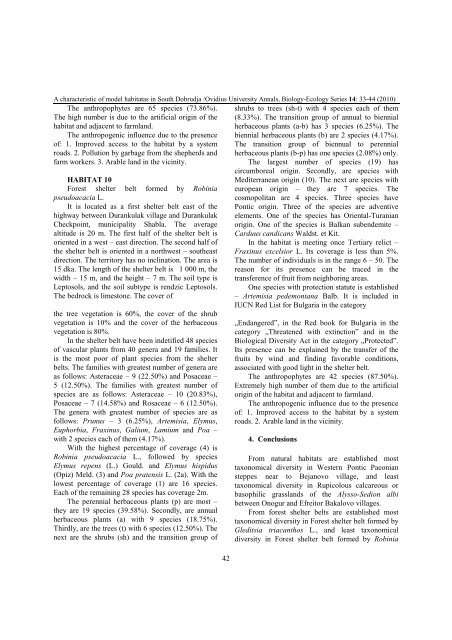VOLUM OMAGIAL - Facultatea de Ştiinţe ale Naturii şi Ştiinţe Agricole
VOLUM OMAGIAL - Facultatea de Ştiinţe ale Naturii şi Ştiinţe Agricole
VOLUM OMAGIAL - Facultatea de Ştiinţe ale Naturii şi Ştiinţe Agricole
Create successful ePaper yourself
Turn your PDF publications into a flip-book with our unique Google optimized e-Paper software.
A characteristic of mo<strong>de</strong>l habitatas in South Dobrudja /Ovidius University Annals, Biology-Ecology Series 14: 33-44 (2010)<br />
The anthropophytes are 65 species (73.86%).<br />
The high number is due to the artificial origin of the<br />
habitat and adjacent to farmland.<br />
The anthropogenic influence due to the presence<br />
of: 1. Improved access to the habitat by a system<br />
roads. 2. Pollution by garbage from the shepherds and<br />
farm workers. 3. Arable land in the vicinity.<br />
HABITAT 10<br />
Forest shelter belt formed by Robinia<br />
pseudoacacia L.<br />
It is located as a first shelter belt east of the<br />
highway between Durankulak village and Durankulak<br />
Checkpoint, municipality Shabla. The average<br />
altitu<strong>de</strong> is 20 m. The first half of the shelter belt is<br />
oriented in a west – east direction. The second half of<br />
the shelter belt is oriented in a northwest – southeast<br />
direction. The territory has no inclination. The area is<br />
15 dka. The length of the shelter belt is 1 000 m, the<br />
width – 15 m, and the height – 7 m. The soil type is<br />
Leptosols, and the soil subtype is rendzic Leptosols.<br />
The bedrock is limestone. The cover of<br />
the tree vegetation is 60%, the cover of the shrub<br />
vegetation is 10% and the cover of the herbaceous<br />
vegetation is 80%.<br />
In the shelter belt have been in<strong>de</strong>tified 48 species<br />
of vascular plants from 40 genera and 19 families. It<br />
is the most poor of plant species from the shelter<br />
belts. The families with greatest number of genera are<br />
as follows: Asteraceae – 9 (22.50%) and Рosaceae –<br />
5 (12.50%). The families with greatest number of<br />
species are as follows: Asteraceae – 10 (20.83%),<br />
Рosaceae – 7 (14.58%) and Rosaceae – 6 (12.50%).<br />
The genera with greatest number of species are as<br />
follows: Prunus – 3 (6.25%), Artemisia, Elymus,<br />
Euphorbia, Fraxinus, Galium, Lamium and Poa –<br />
with 2 species each of them (4.17%).<br />
With the highest percentage of coverage (4) is<br />
Robinia pseudoacacia L., followed by species<br />
Elymus repens (L.) Gould. and Elymus hispidus<br />
(Opiz) Meld. (3) and Poa pratensis L. (2а). With the<br />
lowest percentage of coverage (1) are 16 species.<br />
Each of the remaining 28 species has coverage 2m.<br />
The perennial herbaceous plants (p) are most –<br />
they are 19 species (39.58%). Secondly, are annual<br />
herbaceous plants (a) with 9 species (18.75%).<br />
Thirdly, are the trees (t) with 6 species (12.50%). The<br />
next are the shrubs (sh) and the transition group of<br />
42<br />
shrubs to trees (sh-t) with 4 species each of them<br />
(8.33%). The transition group of annual to biennial<br />
herbaceous plants (а-b) has 3 species (6.25%). The<br />
biennial herbaceous plants (b) are 2 species (4.17%).<br />
The transition group of biennual to perennial<br />
herbaceous plants (b-р) has one species (2.08%) only.<br />
The largest number of species (19) has<br />
circumboreal origin. Secondly, are species with<br />
Mediterranean origin (10). The next are species with<br />
european origin – they are 7 species. The<br />
cosmopolitan are 4 species. Three species have<br />
Pontic origin. Three of the species are adventive<br />
elements. One of the species has Oriental-Turanian<br />
origin. One of the species is Balkan suben<strong>de</strong>mite –<br />
Carduus candicans Waldst. et Kit.<br />
In the habitat is meeting once Tertiary relict –<br />
Fraxinus excelsior L. Its coverage is less than 5%.<br />
The number of individuals is in the range 6 – 50. The<br />
reason for its presence can be traced in the<br />
transference of fruit from neighboring areas.<br />
One species with protection statute is established<br />
– Artemisia pe<strong>de</strong>montana Balb. It is inclu<strong>de</strong>d in<br />
IUCN Red List for Bulgaria in the category<br />
„Endangered”, in the Red book for Bulgaria in the<br />
category „Threatened with extinction” and in the<br />
Biological Diversity Act in the category „Protected”.<br />
Its presence can be explained by the transfer of the<br />
fruits by wind and finding favorable conditions,<br />
associated with good light in the shelter belt.<br />
The anthropophytes are 42 species (87.50%).<br />
Extremely high number of them due to the artificial<br />
origin of the habitat and adjacent to farmland.<br />
The anthropogenic influence due to the presence<br />
of: 1. Improved access to the habitat by a system<br />
roads. 2. Arable land in the vicinity.<br />
4. Conclusions<br />
From natural habitats are established most<br />
taxonomical diversity in Western Pontic Paeonian<br />
steppes near to Bejanovo village, and least<br />
taxonomical diversity in Rupicolous calcareous or<br />
basophilic grasslands of the Alysso-Sedion albi<br />
between Onogur and Efreitor Bakalovo villages.<br />
From forest shelter belts are established most<br />
taxonomical diversity in Forest shelter belt formed by<br />
Gleditsia triacanthos L., and least taxonomical<br />
diversity in Forest shelter belt formed by Robinia





